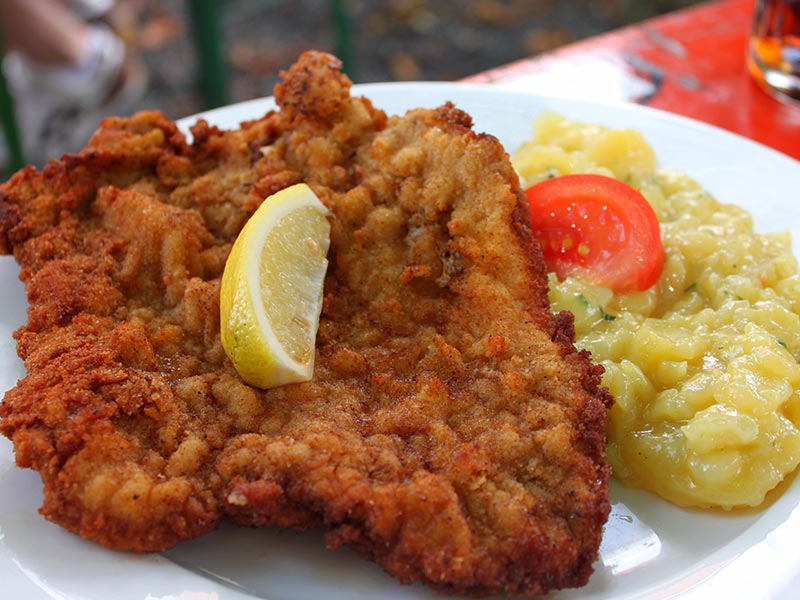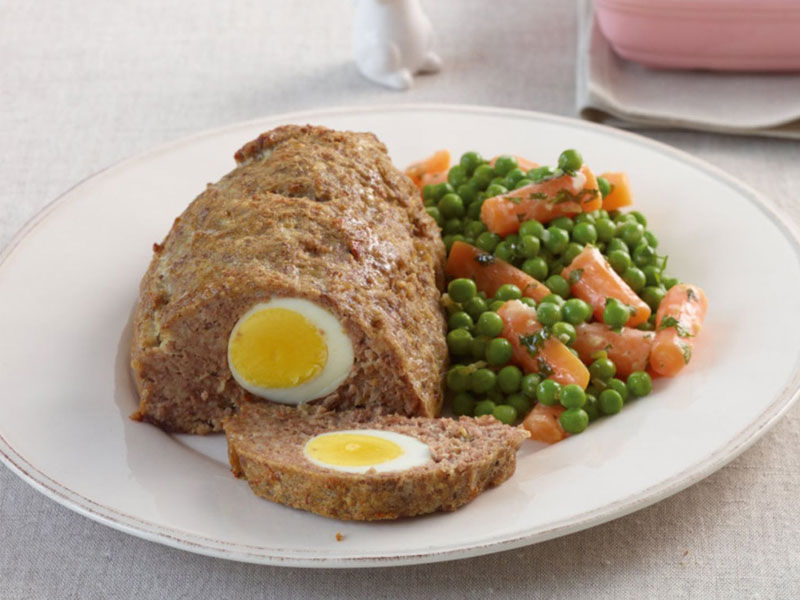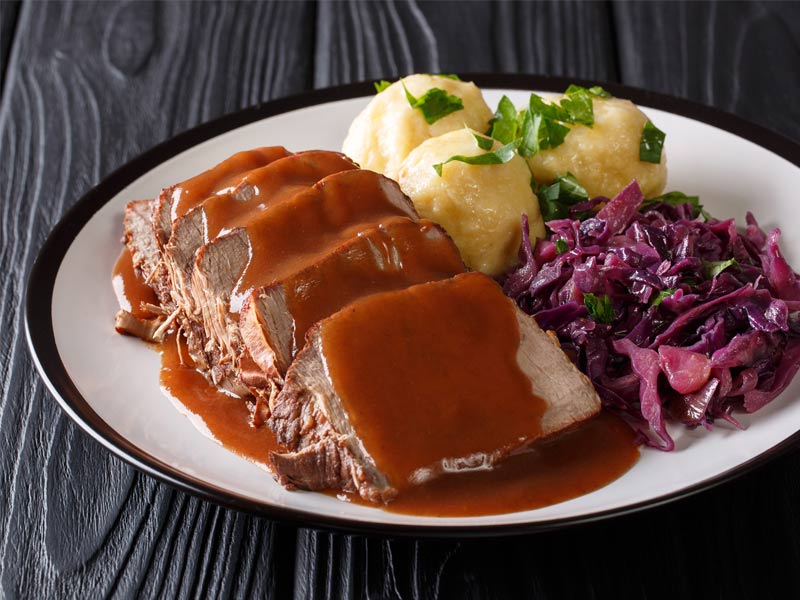When most people think of traditional German food, they think of sausage, sauerkraut, and beer – yet German food is much more than these three things.
Germany has a long culinary tradition that reflects its rural roots and environment. German food has evolved as a national food over centuries of social and political upheaval. Each region has a particular specialty and flavor.
For example, the area near Hamburg is famed for fresh sh dishes, while the South is known for various sorts of pig meals. But they all have a German heartiness and richness that you won’t find anywhere else.
The three foundations of traditional German food are sausages, sauerkraut, and beer. Sausages and wieners are a source of national pride; cabbage is the basis for everything in German food. The beer is so delicious that travelers from all over the world flock to the Oktoberfest annual beer festival.
Nonetheless, despite these well-known brands, regional German food is not restricted to these items. It is worth noting that each area of the nation has its own culinary specialties and traditional meals that will satisfy gourmets with their variety, consistency, and good flavor.
Bratwurst

What is one of the first meals to try in Germany? Bratwurst That’s right, bratwurst, a classic German meal. The term Bratwurst refers to a collection of sausages meant to be cooked in a pan or on the grill. They are typically prepared with minced pork in a natural casing.
Bratwurst is traditionally eaten with sauerkraut, fried potatoes, or potato salad. Bratwurst is typically served with bread, mustard, ketchup, or horseradish at street vendors.
Weißwurst (Bacon Sausage) – a white veal and pig sausage with pork back or fat added. Munich’s most popular German dish is boiled white sausage, which should not be missed while visiting South Germany.
Currywurst (Spicy Sausage) – spicy minced pork sausages that smell so good you can smell them from a mile away. This German food is very popular among Berliners. In Berlin, there is even a museum dedicated entirely to Currywurst.
Schnitzel

Schnitzel is a popular meal in Germany that comes in a variety of cooking styles. Calf schnitzel (also known as “Vienna schnitzel”) and pork schnitzel are the two most popular.
Schnitzels are thin boneless meat chops from the matching animal’s hip.
Along with the traditional German dish of breaded schnitzel, there are variations such as Hamburg schnitzel, which is served with fried eggs and onions. Spreewald Schnitzel is breaded, slathered with horseradish, topped with pickled cucumber slices, then baked with cheese. A fried egg is placed on top of the Holstein Schnitzel.
Schnitzel can be paired with several side dishes, such as potatoes and sauerkraut. And the good news is that all of these variants are considered real German food, so you may eat whatever you want!
Maultaschen

Giant Maultaschen dumplings are a must-try for anybody seeking to experience something out of the ordinary when it comes to classic German food. They are boiled in beef broth and packed with minced pork, bacon, ham, spinach, nutmeg, marjoram, and parsley.
This German dish originated in South German Swabia, where it is also known as Herrgottsbescheißerle.
The culinary innovation, according to German folklore, belongs to the monks of the Maulbronn monastery. On Good Friday, when it is forbidden to consume meat, devious followers have discreetly changed the dumpling stuffing from greens to meat.
Königsberger Klopse
Experienced visitors think that the famous Prussian meatballs are the greatest food to taste in eastern Germany; you’ll need that energy to enjoy the breathtaking vistas of Bavarian lakes! The Konigsberger Klopse recipe first originated in the 19th century in Konigsberg.
Semi-finished items of this famous German food are offered in supermarkets as well as in tin boxes. However, authentic Koenigsberger Klopse should be tried at traditional German restaurants.
Also Read, The amazing Desserts from the land of Deserts, Arabic Desserts
Falscher Hase

One of the most well-known German food is a basic casserole with an amusing name. Falscher Hase is filled with hard-boiled eggs and made with minced pork, onion, and potatoes.
During a food scarcity following World War II, the Falsche Hase dish first arose in Germany. Roasted rabbits and hares were formerly a popular Sunday dinner dish in Germany. Still, they have nearly vanished as a result of repeated bombings.
Housewives with a business sense discovered a way out. They devised a roll with the upper portion resembling an animal’s back.
Rinderrouladen
A high-calorie dish that is a regular “guest” at traditional family Sunday dinners and may legitimately be termed authentic German fare. It is very popular in Germany during the winter months.
The beef tenderloin is wrapped in long thin layers over a filling of bacon, mustard, onion, and pickled cucumber. Rinderrouladen’s specialty is a spicy black sauce prepared from broth, red wine, and veggies with a wonderful fragrance.
This classic German meal’s distinctive rich flavor is created by combining basic ingredients, which wonderfully complements the side dish of stewed cabbage, boiled potatoes, or flour dumplings.
Berliner Eisbein

Berliner Eisbein is a favorite among East Germans and a must-try German dish for real meat lovers. The pig shank is first braised in German lager before being baked with garlic, onions, juniper berries, and spices. This classic German meal is large enough to serve three people.
The German word Eisbein translates as “an ice foot.” Its ancient meal was given this name since the locals-only ate it during the winter frosts. Furthermore, the wonderful crunch on the shin shines as if it were covered in ice. Berliner Eisbein is served at restaurants in Berlin and other German towns with stewed sauerkraut and pea puree.
Sauerbraten

A classic marinated beef roast that is mostly made during the cold season. From three to ten days before cooking, veal, pig, lamb, deer, or even horse meat is marinated in a particular sauce of wine or vinegar, as well as water, with various flavors, spices, and herbs.
In different locations, different preparation methods are employed: for example, closer to France, red wine is used as the base for the marinade, but in Eastern Germany, near the Czech Republic and Poland, vinegar is used. They add beetroot syrup and raisins in the Rhine area.
Sauerbraten is typically served with side dishes such German potato dumplings, boiled potatoes, red cabbage, and Spätzle.
Kartoffelsalat
(Potato Salad) is a popular European meal, particularly in the Czech Republic, Austria, and Germany. This salad is delicious on its own and maybe served as a side dish or as a main course.
This salad has probably 100 variations. Everyone prepares it differently, which is fantastic since you can cook it to your and your family’s preference. The recipe is straightforward, and it doesn’t take long to prepare.
Smaller potatoes are preferred in Germany because they cook faster. Potatoes are always cooked in their skins to conserve more vitamins. Most recipes call for additional peeling or, in some cases, keeping the skin on for higher nutritional value.
The classic Kartoffelsalat salad recipe does not include meat, but alternative variations may include sausages, fish, or other meats. A dressing of mayonnaise, French mustard, and lemon-marinated onions also plays an important part.
Käsespätzle

Believe it or not, German food isn’t all about meat. Take, for example, Käsespätzle, a typical Allgäu, and Swabia dish. Käsespätzle is a close cousin to American mac & cheese, however instead of pasta, they use handmade noodles.
This dinner is inexpensive and simple to make: use the same dough as for dumplings, sift it, boil it, and then bake it with cheese. As a consequence, you’ll get a type of dish with cheese flavor and threads of melting cheese – a cheese lover’s dream! The meal is served hot from the oven, topped with fried onions.
Schwarzwaelder Kirschtorte
It’s impossible to explore German food without sampling some of its greatest desserts! The most renowned and maybe most popular dessert in Germany is Schwarzwaelder Kirschtorte. Cake drenched in liquor, topped with whipped cream, cherries, and bitter chocolate.
The multilayer cake was first mentioned in print in 1915, when Josef Keller, a confectioner from Bavaria, adorned chocolate cakes, which were fashionable at the time, with cream and cherries. By 1930, the recipe for this traditional German dish had spread throughout the country.

























